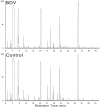Glutamate and lipid metabolic perturbation in the hippocampi of asymptomatic borna disease virus-infected horses
- PMID: 24956478
- PMCID: PMC4067290
- DOI: 10.1371/journal.pone.0099752
Glutamate and lipid metabolic perturbation in the hippocampi of asymptomatic borna disease virus-infected horses
Abstract
Borna disease virus (BDV) is a neurotropic, enveloped, non-segmented, negative-stranded RNA virus that infects a wide variety of vertebrate species from birds to humans across a broad global geographic distribution. Animal symptomatology range from asymptomatic infection to behavioral abnormalities to acute meningoencephalitis. Asymptomatic BDV infection has been shown to be more frequent than conventionally estimated. However, the molecular mechanism(s) underyling asymptomatic BDV infection remain largely unknown. Here, based on real-time quantitative PCR and Western blotting, a total of 18 horse hippocampi were divided into BDV-infected (n = 8) and non-infected control (n = 10) groups. A gas chromatography coupled with mass spectrometry (GC-MS) metabolomic approach, in conjunction with multivariate statistical analysis, was used to characterize the hippocampal metabolic changes associated with asymptomatic BDV infection. Multivariate statistical analysis showed a significant discrimination between the BDV-infected and control groups. BDV-infected hippocampi were characterized by lower levels of D-myo-inositol-1-phosphate, glutamate, phosphoethanolamine, heptadecanoic acid, and linoleic acid in combination with a higher level of ammonia. These differential metabolites are primarily involved in glutamate and lipid metabolism. These finding provide an improved understanding of hippocampal changes associated with asymptomatic BDV infection.
Conflict of interest statement
Figures



Similar articles
-
GC-MS-Based Metabonomic Profiling Displayed Differing Effects of Borna Disease Virus Natural Strain Hu-H1 and Laboratory Strain V Infection in Rat Cortical Neurons.Int J Mol Sci. 2015 Aug 17;16(8):19347-68. doi: 10.3390/ijms160819347. Int J Mol Sci. 2015. PMID: 26287181 Free PMC article.
-
[Distribution of Borna disease virus in naturally infected animals with clinical disease].Berl Munch Tierarztl Wochenschr. 1996 May;109(5):178-83. Berl Munch Tierarztl Wochenschr. 1996. PMID: 8694747 German.
-
Demonstration of Borna disease virus (BDV) in specific regions of the brain from horses positive for serum antibodies to BDV but negative for BDV RNA in the blood and internal organs.Med Microbiol Immunol. 1997 Jun;186(1):19-24. doi: 10.1007/s004300050041. Med Microbiol Immunol. 1997. PMID: 9255762
-
Borna disease virus and infection in humans.Front Biosci. 2002 Feb 1;7:d470-95. doi: 10.2741/A789. Front Biosci. 2002. PMID: 11815287 Review.
-
Borna disease virus and psychiatry.Eur Psychiatry. 2001 Feb;16(1):3-10. doi: 10.1016/s0924-9338(00)00529-0. Eur Psychiatry. 2001. PMID: 11246286 Review.
Cited by
-
Tumor Necrosis Factor-α Receptor 1 Mediates Borna Disease Virus 1-Induced Changes in Peroxisomal and Mitochondrial Dynamics in Neurons.Int J Mol Sci. 2024 Feb 3;25(3):1849. doi: 10.3390/ijms25031849. Int J Mol Sci. 2024. PMID: 38339126 Free PMC article.
-
The equine species as Trojan horse for Borna Disease Virus-1?Vet Q. 2018 Dec;38(1):126-128. doi: 10.1080/01652176.2019.1551172. Vet Q. 2018. PMID: 30773123 Free PMC article. No abstract available.
-
Activation of ERK/CREB/BDNF pathway involved in abnormal behavior of neonatally Borna virus-infected rats.Neuropsychiatr Dis Treat. 2018 Nov 15;14:3121-3132. doi: 10.2147/NDT.S176399. eCollection 2018. Neuropsychiatr Dis Treat. 2018. PMID: 30532543 Free PMC article.
-
GC-MS-Based Metabonomic Profiling Displayed Differing Effects of Borna Disease Virus Natural Strain Hu-H1 and Laboratory Strain V Infection in Rat Cortical Neurons.Int J Mol Sci. 2015 Aug 17;16(8):19347-68. doi: 10.3390/ijms160819347. Int J Mol Sci. 2015. PMID: 26287181 Free PMC article.
-
Central Nervous System Infection with Borna Disease Virus Causes Kynurenine Pathway Dysregulation and Neurotoxic Quinolinic Acid Production.J Virol. 2017 Jun 26;91(14):e00673-17. doi: 10.1128/JVI.00673-17. Print 2017 Jul 15. J Virol. 2017. PMID: 28446679 Free PMC article.
References
-
- Ludwig H, Bode L (2000) Borna disease virus: new aspects on infection, disease, diagnosis and epidemiology. Rev Sci Tech 19: 259–288. - PubMed
-
- De la Torre JC, Bode L, Carbone K, Dietzschold B, Ikuta K, et al... (2000) Family Bornaviridae. In: Van Regenmortel MHV, Fauquet CM, Bishop DHL, editors. Virus Taxonomy: Classification and Nomenclature of Viruses: Seventh Report of the International Committee on Taxonomy of Viruses. London, England: Academic Press. pp. 531–538.
-
- Ludwig H, Thein P (1977) Demonstration of specific antibodies in the central nervous system of horses naturally infected with Borna disease virus. Med Microbiol Immunol 163: 215–226. - PubMed
-
- Ludwig H, Kraft W, Kao M, Gosztonyi G, Dahme E, et al. (1985) Borna virus infection (Borna disease) in naturally and experimentally infected animals: its significance for research and practice. Tierarztl Prax 13: 421–453. - PubMed
-
- Rott R, Becht H (1995) Natural and experimental Borna disease in animals. Curr Top Microbiol Immunol 190: 17–30. - PubMed
Publication types
MeSH terms
Substances
LinkOut - more resources
Full Text Sources
Other Literature Sources
Molecular Biology Databases
Miscellaneous

